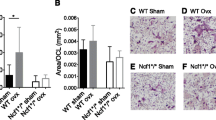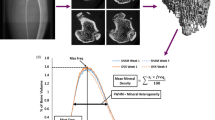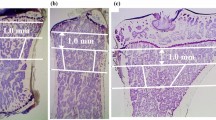Abstract
We previously reported that mast cells accumulate in the tibia bone marrow of ovariectomized (OVX) rats. In this study, the timing of mast cell accumulation and osteoclast generation were compared to determine whether or not mast cell accumulation preceded osteoclast recruitment after ovariectomy. This may be significant because of the number of cytokines released by mast cells that are potentially active on resorption. Sprague-Dawley rats (120) aged 12 weeks were OVX or sham-operated, and killed on days 4, 7, 14, 28, and 56 postsurgery. Ten additional intact rats were used as baseline controls. Ovariectomy was confirmed by a sharp and sustained fall in serum estradiol. The loss in trabecular bone volume (BV/TV) began on day 7, reaching 80% on day 56 (P<0.001 vs baseline controls). The number of osteoclasts (N.OC/TBPm) increased in the OVX rats between days 4 and 7 (+130%;P<0.001), and continued rising to day 28. During the next month, it decreased greatly (−63%,P<0.001 on day 56 vs day 28). In the sham-treated rats, few mast cells were scattered in the bone marrow (1.9 cells/mm2 in the baseline controls). Their number fluctuated during the experimental period, but at each time-point it was lower than in the OVX rats. They were predominantly (90%) of the mucosal subtype. In the OVX rats, their number doubled between days 4 and 14 (P<0.001), reached 8.6 cells/mm2 on day 28 (a 5.4-fold increase compared with day 4 OVX rats), and plateaued for the next 4 weeks. OVX had no effects on mast cell subtypes. In conclusion, mast cell accumulation and osteoclast differentiation are precocious and concomitant; this does not support a direct role for mast cells in osteoclast recruitment. Rather, the two cell populations may derive from a common precursor or be targeted simultaneously by estrogen depletion through common stimulator(s). Mast cell hyperplasia appears to be a significant, and usually unknown, manifestation of ovariectomy in the bone marrow environment.
Similar content being viewed by others
References
Saffar JL, Klapisz-Wolikow M (1990) Changes in mast cell number during the activation phase of an induced synchronized remodeling sequence in the rat. Bone 11:369–372
Dobigny C, Saffar JL (1991) Partial inhibition of bone resorption by disodium cromoglycate in a synchronized model of bone remodeling. Agents Actions 33:326–329
Lesclous Ph, Saffar JL (1999) Mast cells accumulate in rat bone marrow after ovariectomy. Cells Tissues Organs 164:23–29
Ellis HA, Peart KM (1976) Iliac bone marrow mast cells in relation to the renal osteodystrophy of patients treated by haemodialysis. J Clin Pathol 29:502–516
Fallon MD, Whyte MP, Craig RB, Teitelbaum SL (1983) Mast-cell proliferation in postmenopausal osteoporosis. Calcif Tissue Int 35:29–31
McKenna MJ (1994) Histomorphometric study of mast cells in normal bone, osteoporosis, and mastocytosis using a new stain. Calcif Tissue Int 55:257–259
Feik SA, Storey E (1979) Low calcium/high phosphorus rickets in rats. I Mast cell changes. Pathology 11:641–652
Rockoff SD, Amstrong JD (1970) Parathyroid hormone as a stimulus to mast cell accumulation in bone. Calcif Tissue Res 5:49–55
Rasmussen P (1972) An experimental study of mast cells in the rat metaphysis. Calcif Tissue Res 9:325–330
Andrew SM, Freemont AJ (1993) Skeletal mastocytosis. J Clin Pathol 46:1033–1035
Chines A, Pacifici R, Avioli LV, Teitelbaum SL, Korenblat PE (1991) Systemic mastocytosis presenting as osteoporosis—a clinical and histomorphometric study. J Clin Endocrinol Metab 72:140–144
de Gennes C, Kuntz D, de Vernejoul MC (1992) Bone mastocytosis—a report of nine cases with a bone histomorphometric study. Clin Orthop Rel Res 279:281–291
Harvey JA, Anderson HC, Borek D, Morris D, Lukert BP (1989) Osteoporosis associated with mastocytosis confined to bone: report of two cases. Bone 10:237–241
Metcalfe DD, Baram D, Mekori YA (1997) Mast cells. Physiol Rev 77:1033–1079
Theoharides TC (1996) The mast cell: a neuroimmunoendocrine master player. Int J Tissue React 18:1–21
Jilka RL (1998) Cytokines, bone remodeling, and estrogen deficiency: a 1998 update. Bone 23:75–81
Liggett W, Shevde N, Anklesaria P, Sohoni S, Greenberger J, Glowacki J (1993) Effects of macrophage colony-stimulating and granulocyte-macrophage colony-stimulating factor on osteoclastic differentiation of hematopoietic progenitor cells. Stem Cells 11:398–411
Chowdhury MH, Hamada C, Dempster DW (1992) Effects of heparin on osteoclast activity. J Bone Miner Res 7:771–777
Fuller K, Chambers TJ, Gallagher AC (1991) Heparin augments osteoclast resorption-stimulating activity in serum. J Cell Physiol 147:208–214
Ginsberg JS, Kowalchuk G, Hirsh J, Brilledwards P, Burrows R, Coates G, Webber C (1990) Heparin effect on bone density. Thromb Haemost 64:286–289
Muir JM, Hirsh J, Weitz JI, Andrew M, Young E, Shaughnessy SGA (1997) Histomorphometric comparison of the effects of heparin and low-molecular-weight heparin on cancellous bone in rats. Blood 89:3236–3242
Enerbäck L (1986) Mast cell heterogeneity: the evolution of the concept of a specific mucosal mast cell. In: Befus AD, Bienenstock J, Denburg JA (eds) Mast cell differentiation and heterogeneity. Raven Press, New York, pp 1–26
Dimitriadou V, Buzzi MG, Moskowitz MA, Theoharides TC (1991) Trigeminal sensory fiber stimulation induces morphological changes reflecting secretion in rat dura mater mast cells. Neuroscience 44:97–112
Frost HM, Jee WSS (1992) On the rat model of human osteopenias and osteoporosis. Bone Miner 18:227–236
Wronski TJ, Cintron M, Dann LM (1988) Temporal relationship between bone loss and increased bone turnover in ovariectomized rats. Calcif Tissue Int 43:179–183
Jilka RL, Takahashi K, Munshi M, Williams DC, Roberson PK, Manolagas SC (1998) Loss of estrogen upregulates osteoblastogenesis in the murine bone marrow—evidence for autonomy from factors released during bone resorption. J Clin Invest 101:1942–1950
Matayoshi A, Brown C, Dipersio JF, Haug J, Abuamer Y, Liapis H, Kuestner R, Pacifici R (1996) Human blood-mobilized hematopoietic precursors differentiate into osteoclasts in the absence of stromal cells. Proc Natl Acad Sci USA 93:10785–10790
Mbalaviele G, Jaiswal N, Meng A, Cheng LZ, Van den Bos C, Thiede M (1999) Human mesenchymal stem cells promote human osteoclast differentiation from CD34+ bone marrow hematopoietic progenitors. Endocrinology 140:3736–3743
Ishizaka T, Mitsui H, Yanagida M, Miura T, Dvorak AM (1993) Development of human mast cells from their progenitors. Curr Opin Immunol 5:937–943
Demulder A, Suggs SV, Zsebo KM, Scarcez T, Roodman GD (1992) Effects of stem cell factor on osteoclast-like cell formation in long-term human marrow cultures. J Bone Miner Res 7:1337–1344
Muguruma Y, Lee MY (1998) Isolation and characterization of murine clonogenic osteoclast progenitors by cell surface phenotype analysis. Blood 91:1272–1279
van't Hof RJ, von Lindern M, Nijweide PJ, Beug H (1997) Stem cell factor stimulates chicken osteoclast activity in vitro. FASEB J 11:287–293
Aye MT, Hashemi S, Leclair B, Zeibdawi A, Trudel E, Halpenny M, Fuller V, Cheng G (1992) Expression of stem cell factor and c-kit mRNA in cultured endothelial cells, monocytes and cloned human bone marrow stromal cells (CFURF). Exp Hematol 20:523–527
Toksoz D, Zsebo KM, Smith KA, Hu S, Brankow D, Suggs SV, Martin FH, Williams DA (1992) Support of human hematopoiesis in long-term bone marrow cultures by murine stromal cells selectively expressing the membrane-bound and secreted forms of the human homolog of the steel gene product, stem cell factor. Proc Natl Acad Sci USA 89:7350–7354
Blair HC, Dong SS, Julian BA (1999) Expression of stem cell factor by osteoblasts in normal and hyperparathyroid bone: relation to ectopic mast cell differentiation. Virchows Arch 35:50–57
Ahmed N, Khokher MA, Hassan HT (1999) Cytokine-induced expansion of human CD34+ stem/progenitor and CD34+CD41+ early megakariocytic marrow cells cultured on normal osteoblasts. Stem Cells 17:92–99
Vliagoftis H, Dimitriadou V, Boucher W, Rozniecki JJ, Correia I, Raam S, Theoharides TC (1992) Estradiol augments while tamoxifen inhibits rat mast cell secretion. Int Arch Allergy Immunol 98:398–409
Graves L, Stechsculte DJ, Morris DC, Lukert BP (1990) Inhibition of mediator release in systemic mastocytosis is associated with reversal of bone changes. J Bone Miner Res 5:1113–1120
Schneider E, Piquet-Pellorce C, Dy M (1990) New role for histamine in interleukin-3-induced proliferation of hematopoietic stem cells. J Cell Physiol 143:337–343
Nakamura M, Kuroda H, Narita K, Endo Y (1996) Parathyroid hormone induces a rapid increase in the number of active osteoclasts by releasing histamine from mast cells. Life Sci 58:1861–1868
Dobigny C, Saffar JL (1997) H1 and H2 histamine receptors modulate osteoclastic resorption by different pathways: evidence obtained by using receptor antagonists in a rat synchronized resorption model. J Cell Physiol 173:10–18
Belanger LF (1977) Variations in the mast cell populations of skin and bone marrow in magnesium-deprived rats. The influence of sex hormones. J Nutr 107:2164–2170
Author information
Authors and Affiliations
Rights and permissions
About this article
Cite this article
Lesclous, P., Guez, D., Llorens, A. et al. Time-course of mast cell accumulation in rat bone marrow after ovariectomy. Calcif Tissue Int 68, 297–303 (2001). https://doi.org/10.1007/BF02390837
Received:
Accepted:
Issue Date:
DOI: https://doi.org/10.1007/BF02390837




